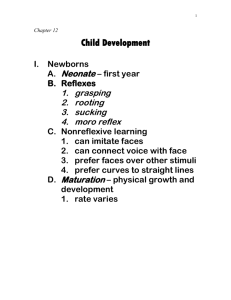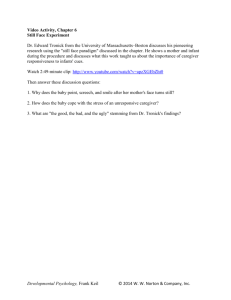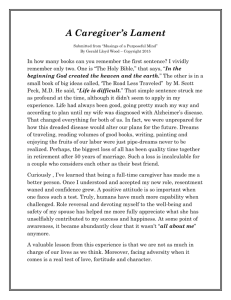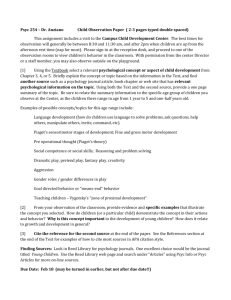Lifespan Development
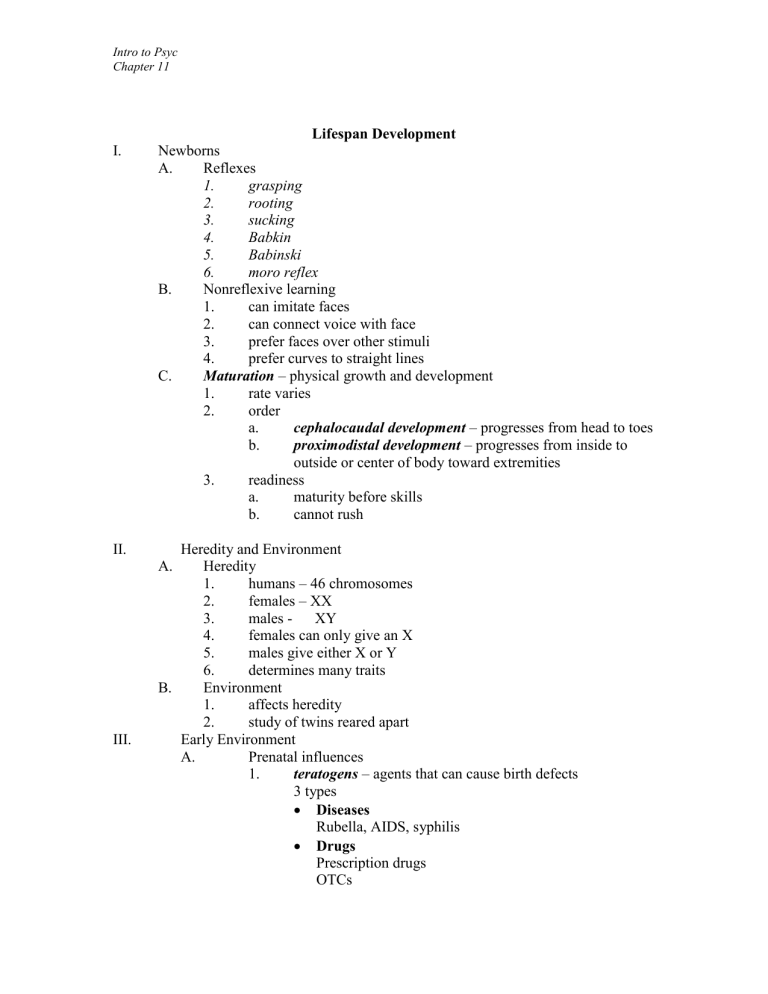
Intro to Psyc
Chapter 11
I.
Lifespan Development
Newborns
A.
Reflexes
1.
grasping
2.
rooting
3.
sucking
4.
Babkin
5.
Babinski
6.
moro reflex
B.
Nonreflexive learning
1.
can imitate faces
2.
can connect voice with face
3.
prefer faces over other stimuli
4.
prefer curves to straight lines
C.
Maturation – physical growth and development
1.
rate varies
2.
order a.
cephalocaudal development – progresses from head to toes b.
proximodistal development – progresses from inside to outside or center of body toward extremities
3.
readiness a.
maturity before skills b.
cannot rush
II.
III.
Heredity and Environment
A.
Heredity
1.
humans – 46 chromosomes
2.
females – XX
3.
males - XY
4.
females can only give an X
5.
males give either X or Y
6.
determines many traits
B.
Environment
1.
affects heredity
2.
study of twins reared apart
Early Environment
A.
Prenatal influences
1.
teratogens – agents that can cause birth defects
3 types
Diseases
Rubella, AIDS, syphilis
Drugs
Prescription drugs
OTCs
Intro to Psyc
Chapter 11
IV.
B.
Illicit drugs
Caffeine, nicotine, aspartame
Environmental Agents x-rays, radiation, pollution, toxins, fumes, taxoplasmosis
Childbirth
1.
conventional delivery
2.
prepared childbirth
3.
LeMaze method
4.
LeBoyer method
Social Development
A.
B.
Self-awareness – how do I know it’s me
Mirror Studies
Social Referencing – looking to others for how to respond in a situation
C.
Imprinting pattern
– rapid and early learning of a permanent behavior
D.
Critical Period – behaviors that must be learned by a specified age
(or it doesn’t happen at all)
E.
Attachment – enduring bond that occurs between infant and caregiver that develops over time
1.
separation anxiety – child’s distress when parent leaves
2.
kinds of attachment a.
secure attachment
1.
child upset when caregiver leaves
2.
wants to be near when caregiver returns
3. b.
anxious or insecure avoidant attachment
1.
child doesn’t care if caregivers leaves
2.
will readily go with a stranger
3.
turns away when caregiver returns
4.
shows little desire to be with caregiver c.
anxious ambivalent attachment
1.
wants caregiver present, but doesn’t pursue contact
2.
wants yet rejects caregiver attachment type affects child’s personality a.
secure children
1.
make friends easily
2.
do better in school
3.
show self-control b.
insecure children
1.
often whiny and demanding
2.
do not make friends easily
3.
show poor self-control
4.
Intro to Psyc
Chapter 11
V.
4. caregiving style
5. a. b. sensitive care
1.
responding quickly and efficiently to baby’s needs
2.
plays with baby when alert and active insensitive care
1.
ignore baby’s needs
2.
overstimulate
3.
play with baby when too tired
Daycare
6. ideal
1.
low child:adult ratio
2.
< 20 hrs. per week
3.
after 1 yr. of age
4.
low turnover in workers
Harlow Monkey Studies a.
monkeys separated from mother early
1.
abnormal sexual behaviors
2.
poor mothering skills a.
reject baby b.
little contact c.
brutalize or injury baby b.
relationship to humans
1.
abused people often make poor parents
2.
early rejection may lead to antisocial behavior
7.
You cannot spoil a child in the first year
Cognitive Development
A.
Piaget’s Theory of Cognitive Development
1.
assimilation – acquiring knowledge
2.
accommodation – modifying knowledge when new information available
3.
stages of development a.
Sensorimotor (0 – 2 yrs.)
1.
motor skills used to bring objects within sensory range
2.
object permanence – objects continue to exist when when not in range
3.
separation anxiety – distress when caregiver leaves b.
Preoperational stage
(2 – 7 yrs.)
1.
egocentrism – inability to take viewpoint of another
2.
must manipulate objects
Intro to Psyc
Chapter 11 c.
Concrete operational stage (7 – 11 yrs.)
1.
conservation – things remain the same even when shape is different
3 beaker problem
2.
reversibility - working backwards for a solution d.
formal operations stage (11+ yrs.) thinking is
1.
logical
2.
abstract
3.
hypothetical/deductive
VI.
VII.
Moral Development
Kohlberg’s Theory of Moral Development (based on Piaget’s stages)
Level I Preconventional
Stage 1: punishment/obedience
Stage 2: fairness
Level II
Level III
Conventional
Stage 3: good/bad orientation
Stage 4: law and order
Postconventional
Stage 5: social contract
Stage 6: moral hierarchy
Deprivation and Enrichment
A.
Children in confinement
1.
deprivation dwarfism – stunted growth associated with isolation a.
retardation b.
mutism c.
emotional problems
2.
hospitalism
– condition of deep depression marked by
B.
weeping and rocking or doing nothing
Monkey studies
1.
contact comfort – touching, holding, body warmth,
C.
cuddling with infants
2.
cloth vs wire “mother”
Enrichment
1.
providing a variety of stimulation toys and games
2.
exposure to many things
3.
learn better and faster
4.
read sooner
Intro to Psyc
Chapter 11
VIII.
Erik Erikson’s Psychosocial Theory of Development
Trust vs Mistrust
Autonomy vs Shame and Doubt
Initiative vs Guilt
Industry vs Inferiority
Identity vs Role Confusion
Intimacy vs Isolation
Generativity vs Stagnation
Integrity vs Despair
IX.
Problems in Childhood
A.
Parenting Styles : Baumrind
1.
Authoritarian (Declarative )
2.
Permissive
3.
Authoritative
B.
Normal Childhood Problems
1.
sleep disturbances – sleepwalking, nightmares
2.
specific fears – dark, dogs
3.
overly timid – shy or bullied
4.
general dissatisfaction
5.
general negativism
6.
clinging
7.
regression
8.
sibling rivalry
III.
Serious Problems in Childhood
A.
Toilet training
1.
enuresis – bedwetting
2.
encopresis
– lack of bowel control
B.
Feeding
1.
overeating
2.
anorexia nervosa a.
self-starvation b.
adolescent girls c.
exercise excessively d.
purging; laxatives
3.
pica
– eating nonfood
C.
Learning Disabilities – problems in thinking, perception, language, attention or activity levels
1.
dyslexia – inability to read with understanding; reversal of letters or numbers
2.
Attention Deficit Disorder (ADD) or Attention Deficit Disorder with Hyperactivity (ADHD) a.
stimulants (Ritalin) b.
behavior modification
Intro to Psyc
Chapter 11
D.
Childhood Autism
1.
severe speech deficits echolalia – parrot speech or repeating same word or phrase
2.
extreme need for sameness
3.
stereotypic movement (perseveration) – rocking, finger flicking, spinning
X.
XI.
XII.
Child Abuse
A.
Characteristics of abusive parents
1.
young (under 30)
2.
low SES
3.
high levels of stress or frustration
4.
lack of knowledge of normal childhood dev. or behaviors
5.
come from abusive homes
Adolescence
A.
Puberty – rapid physical growth; reproductive maturity
B.
Identity issues
1.
imaginary audience
2.
adolescent fable a.
unique b.
immortal
3.
conflicts with parents
4.
increased association with peers
Adulthood
A.
Gould & Levinson
B.
C.
Menopause
Climateric
– cessation of menses; inability to bear children
– physiological changes in men; decreased hormone production
XIII.
Aging
A.
B.
C.
Gerontologists
– those who study the process of aging and the elderly
Theories of Aging
1.
Disengagement Theory a.
normal and desirable to withdraw with aging b.
relief from roles and responsibilities c.
vacate positions for younger people d.
not descriptive of all
2.
Activity Theory a.
activity as goal b.
those who are active physically, mentally and c.
socially adjust better maintain activity as long as possible
Ageism – discrimination or prejudice based on age
Intro to Psyc
Chapter 11
D.
Death and Dying
1.
Stages of dying: Elizabeth Kubler-Ross a.
denial b.
anger c.
bargaining d.
depression e.
acceptance
2.
Bereavement and grief a.
shock b.
pangs of grief c.
apathy, dejection, and depression d.
resolution
